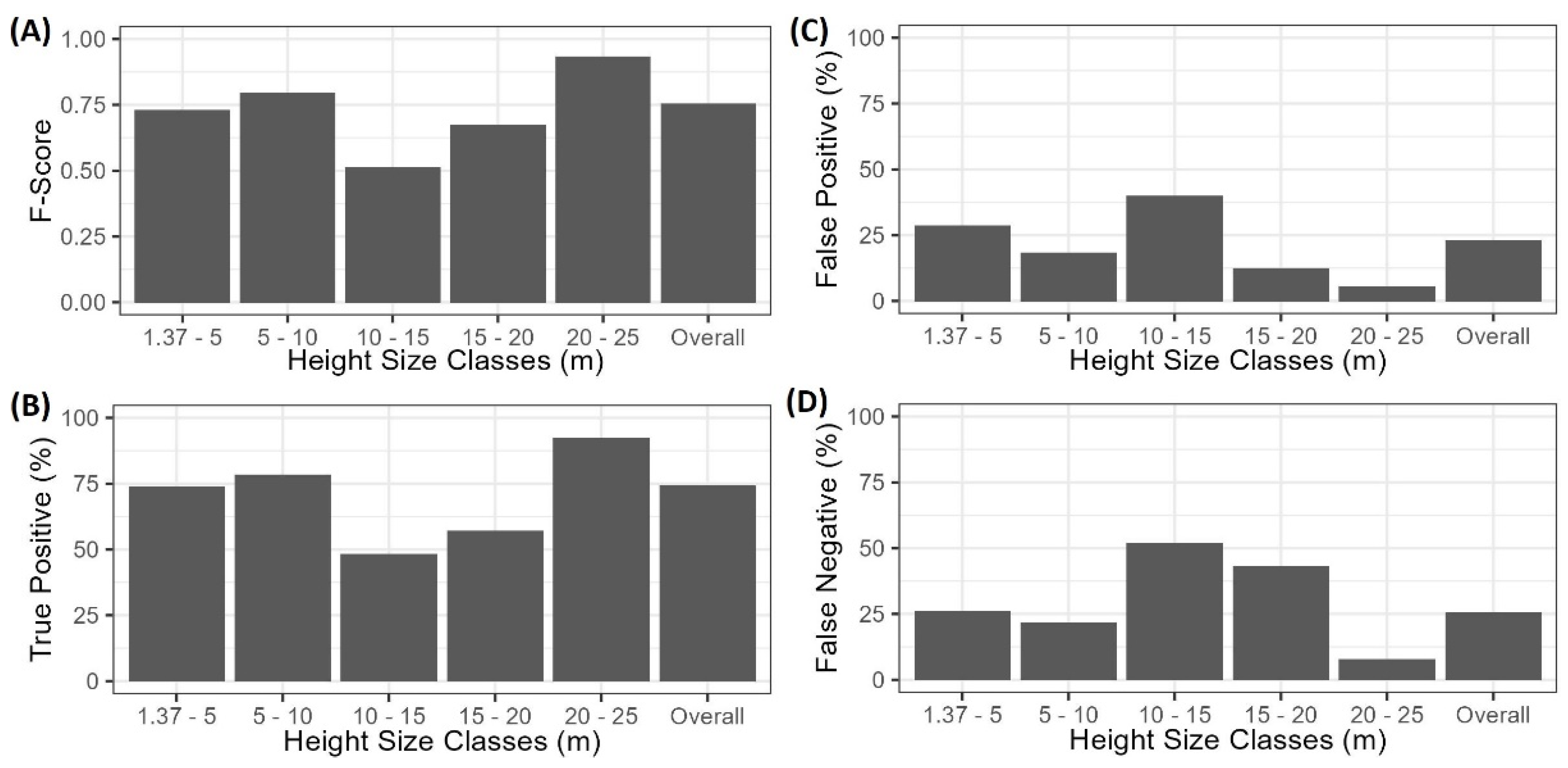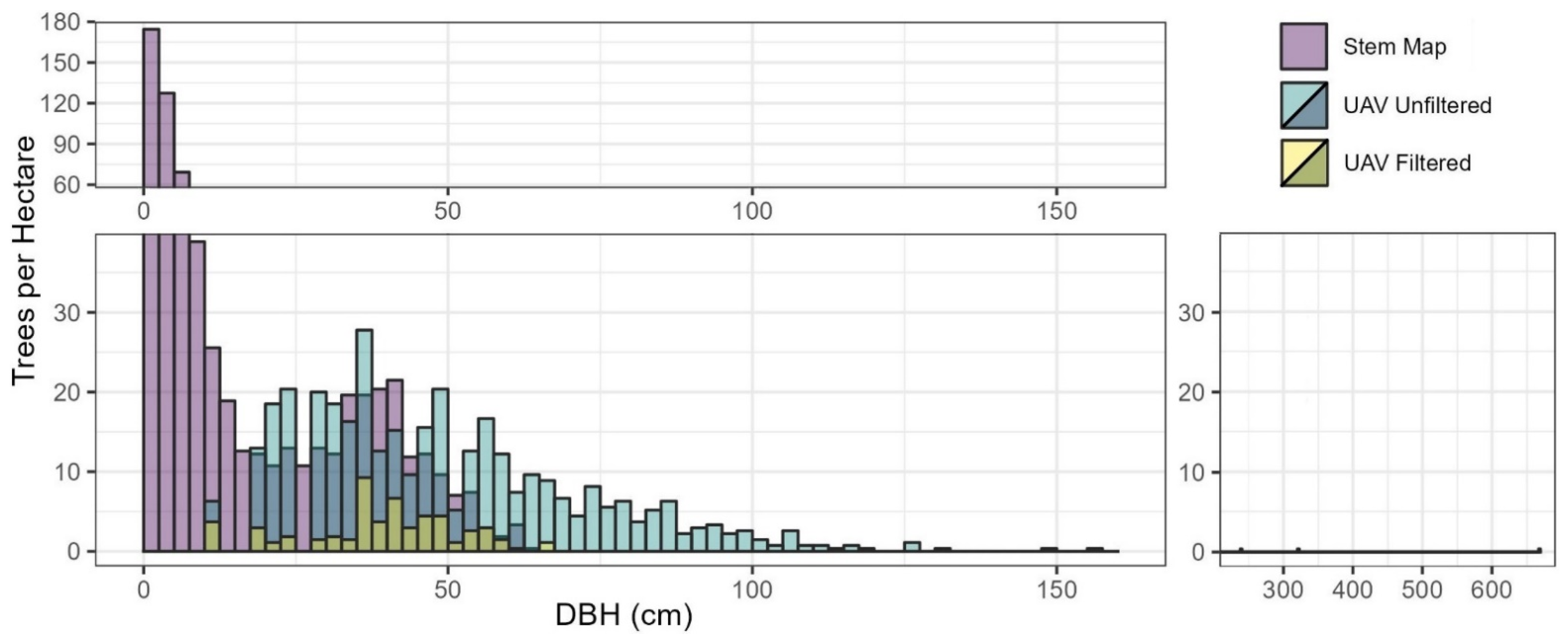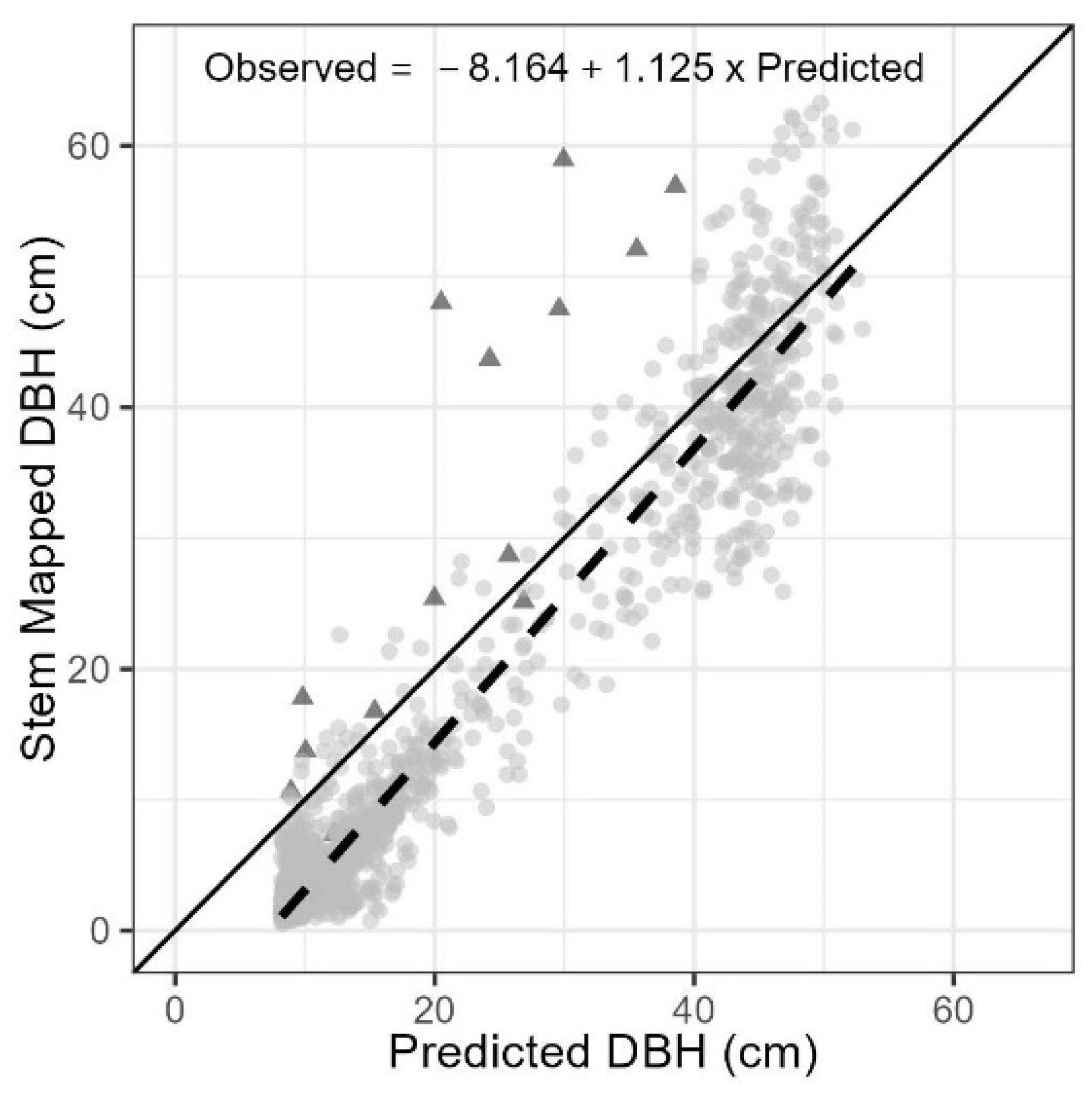Modeling the Missing DBHs: Influence of Model Form on UAV DBH Characterization
Abstract
1. Introduction
2. Materials and Methods
2.1. Study Area and Field Data
2.2. UAV Data Acquisition and Processing
2.3. UAV Tree Parameter Extraction
2.4. Matching of Tree Observations
2.5. DBH Model Fitting and Evaluation
3. Results
3.1. Tree Extraction
3.2. DBH Model Prediction Performance
4. Discussion
4.1. UAV Extracted Trees and DBH Filtering
4.2. DBH Model Fitting and Prediction
4.3. DBH Modeling Limitations
5. Conclusions
Supplementary Materials
Author Contributions
Funding
Institutional Review Board Statement
Informed Consent Statement
Data Availability Statement
Acknowledgments
Conflicts of Interest
References
- Wurtzebach, Z.; DeRose, R.J.; Bush, R.R.; Goeking, S.A.; Healey, S.; Menlove, J.; Pelz, K.A.; Schultz, C.; Shaw, J.D.; Witt, C. Supporting National Forest System Planning with Forest Inventory and Analysis Data. J. For. 2019, 118, 289–306. [Google Scholar] [CrossRef]
- Burkhart, H.E.; Avery, T.E.; Bullock, B.P. Forest Measurements, 6th ed.; Waveland Press Inc.: Long Grove, IL, USA, 2018; p. 434. [Google Scholar]
- Tinkham, W.T.; Hoffman, C.M.; Ex, S.; Smith, A.M.S. Sensitivity of crown fire modeling to inventory parameter dubbing in FVS. In Proceedings of the 2017 Forest Vegetation Simulator (FVS) e-Conference; U.S. Department of Agriculture, Forest Service, Southern Research Station: Asheville, NC, USA, 2017; pp. 114–123, General Technical Report, SRS-eGTR-224. [Google Scholar]
- Weiskittle, A.R.; Hann, D.W.; Kershaw, J.A., Jr.; Vanclay, J.K. Forest Growth and Yield Modeling; Wiley-Blackwell: Chicester, UK, 2011; p. 424. [Google Scholar]
- Roxburch, S.H.; Paul, K.I.; Clifford, D.; England, J.R.; Raison, R.J. Guidelines for constructing allometric models for the prediction of woody biomass: How many individuals to harvest? Ecosphere 2015, 6, 38. [Google Scholar] [CrossRef]
- Johnson, J.B.; Omland, K.S. Model selection in ecology and evolution. Trends Ecol. Evol. 2004, 19, 101–108. [Google Scholar] [CrossRef]
- Nilsson, M. Estimation of tree heights and stand volume using an airborne lidar system. Remote Sens. Environ. 1996, 56, 1–7. [Google Scholar] [CrossRef]
- Popescu, S.C.; Wynne, R.H. Seeing the trees in the forest. Photogram. Engine. Remote Sens. 2004, 70, 589–604. [Google Scholar] [CrossRef]
- Hudak, A.T.; Crookston, N.L.; Evans, J.S.; Falkowski, M.J.; Smith, A.M.S.; Gessler, P.E.; Morgan, P. Regression modeling and mapping of coniferous forest basal area and tree density from discrete-return lidar and multispectral satellite data. Can. J. Remote Sens. 2006, 32, 126–138. [Google Scholar] [CrossRef]
- Falkowski, M.J.; Smith, A.M.S.; Hudak, A.T.; Gessler, P.E.; Vierling, L.A.; Crookston, N.L. Automated estimation of individual conifer tree height and crown diameter via two-dimensional spatial wavelet analysis of lidar data. Can. J. Remote Sens. 2006, 32, 153–161. [Google Scholar] [CrossRef]
- Jeronimo, S.M.A.; Kane, V.; Churchill, D.J.; McGaughey, R.; Franklin, J.F. Applying LiDAR individual tree detection to management of structurally diverse forest landscapes. J. For. 2018, 116, 336–346. [Google Scholar] [CrossRef]
- Tinkham, W.T.; Smith, A.M.S.; Affleck, D.L.R.; Saralecos, J.D.; Falkowski, M.J.; Hoffman, C.M.; Hudak, A.T.; Wulder, M.A. Development of height-volume relationships in second growth Abies grandis for use with aerial LiDAR. Can. J. Remote Sens. 2016, 42, 400–410. [Google Scholar] [CrossRef]
- Neuville, R.; Bates, J.S.; Jonard, F. Estimating forest structure from UAV-mounted lidar point cloud using machine learning. Remote Sens. 2021, 13, 352. [Google Scholar] [CrossRef]
- Swayze, N.P.; Tinkham, W.T.; Vogeler, J.C.; Hudak, A.T. Influence of flight parameters on UAS-based monitoring of tree height, diameter, and density. Remote Sens. Environ. 2021, 263, 112540. [Google Scholar] [CrossRef]
- Creasy, M.B.; Tinkham, W.T.; Hoffman, C.M.; Vogeler, J.C. Potential for individual tree Monitoring in ponderosa pine-dominated forests using unmanned aerial system structure from motion point clouds. Can. J. For. Res. 2021, 51, 1093–1105. [Google Scholar] [CrossRef]
- Silva, C.A.; Hudak, A.T.; Vierling, L.A.; Loudermilk, E.L.; O’Brien, J.J.; Hiers, J.K.; Jack, S.B.; Gonzalez-Benecke, C.; Lee, H.; Falkowski, M.J.; et al. Imputation of Individual Longleaf Pine (Pinus palustris Mill.) Tree Attributes from Field and LiDAR Data. Can. J. Remote Sens. 2016, 42, 554–573. [Google Scholar] [CrossRef]
- Luo, L.; Zhai, Q.; Su, Y.; Ma, Q.; Kelly, M.; Guo, Q. Simple method for direct crown base height estimation of individual conifer trees using airborne LiDAR data. Opt. Express 2018, 26, A562–A578. [Google Scholar] [CrossRef]
- Fritz, A.; Kattenhorn, T.; Koch, B. UAV-based photogrammetric point clouds—Tree stem mapping in open stands in comparison to terrestrial laser scanner point clouds. International Archives of the Photogrammetry. Remote Sens. Spat. Inform. Sci. 2013, XL-1, 141–146. [Google Scholar] [CrossRef]
- Kuželka, K.; Slavik, M.; Surovy, P. Very high density point clouds from UAV laser scanning for automatic tree stem detection and direct diameter measurement. Remote Sens. 2020, 12, 1236. [Google Scholar] [CrossRef]
- Cao, Q.V.; Dean, T.J. Predicting diameter at breast height from total height and crown length. In Proceedings of the 15th Biennial Southern Silviculture Research Conference; Guldin, J.M., Ed.; e-General Technical Report, SRS-GTR-175; U.S. Department of Agriculture, Forest Service, Southern Research Station: Asheville, NC, USA, 2013. [Google Scholar]
- Tinkham, W.T.; Swayze, N.C. Influence of Agisoft Metashape parameters on UAS structure from motion individual tree detection from canopy height models. Forests 2021, 12, 250. [Google Scholar] [CrossRef]
- Roussel, J.R.; Auty, D.; Coops, N.C.; Tompalski, P.; Goodbody, T.R.; Meador, A.S.; Bourdon, J.; de Boissieu, F.; Achim, A. lidR: An R Package for Analysis of Airborne Laser Scanning (ALS) Data. Remote Sens. Environ. 2020, 251, 112061. [Google Scholar] [CrossRef]
- R Core Team. R: A language and environment for statistical computing. In R Foundation for Statistical Computing; R Core Team: Vienna, Austria, 2021; Available online: https://www.R-project.org/ (accessed on 26 July 2022).
- Swayze, N.P.; Tinkham, W.T. Application of Unmanned Aerial System Structure from Motion Point Cloud Detected Tree Heights and Stem Diameters to model missing Diameter values. MethodsX 2022, 9, 101729. [Google Scholar] [CrossRef]
- Plowright, A. ForestTools: Analyzing Remotely Sensed Forest Data. R Package Version 0.2.0. 2018. Available online: https://CRAN.R-project.org/package=ForestTools (accessed on 26 July 2022).
- Conto, T. TreeLS: Terrestrial Point Cloud Processing of Forest Data. R Package Version 1.0. 2019. Available online: https://CRAN.R-project.org/package=TreeLS (accessed on 26 July 2022).
- Tinkham, W.T.; Mahoney, P.R.; Hudak, A.T.; Domke, G.M.; Falkowski, M.J.; Woodall, C.W.; Smith, A.M.S. Applications of the United States Forest Inventory and Analysis dataset: A review and future directions. Can. J. For. Res. 2018, 48, 1251–1268. [Google Scholar] [CrossRef]
- Lefcheck, J.S. piecewiseSEM: Piecewise Structural Equation Modeling in R for Ecology, Evolution, and Systematics. Methods Ecol. Evol. 2016, 7, 573–579. [Google Scholar] [CrossRef]
- Hao, Z.; Lin, L.; Post, C.J.; Jiang, Y.; Li, M.; Wei, N.; Yu, K. Assessing tree height and density of a young forest using a consumer unmanned aerial vehicle (UAV). New For. 2021, 52, 843–862. [Google Scholar] [CrossRef]
- Belmonte, A.; Sankey, T.; Biederman, J.A.; Bradford, J.; Goetz, S.J.; Kolb, T.; Woolley, T. UAV-derived estimates of forest structure to inform ponderosa pine forest restoration. Remote Sens. Ecol. Conserv. 2020, 6, 181–197. [Google Scholar] [CrossRef]
- Li, W.; Guo, Q.; Jakubowski, M.; Kelly, M. A new method for segmenting individual trees from the lidar point cloud. Photogramm. Eng. Remote Sens. 2012, 78, 75–84. [Google Scholar] [CrossRef]
- Alonzo, M.; Anderson, H.-E.; Morton, D.C.; Cook, B.D. Quantifying boreal forest structure and composition using UAV structure from motion. Forests 2018, 9, 119. [Google Scholar] [CrossRef]
- USDA Forest Service. FSVeg Common Stand Exam Users Guide; Chapter 2: Preparation and Design. Version 2.12.6. 2015. Available online: https://www.fs.fed.us/nrm/documents/fsveg/cse_user_guides/userguide_fsveg_ch2_prep-design.docx. (accessed on 27 August 2022).
- Dalla Corte, A.P.; da Cunha Neto, E.M.; Rex, F.R.; Souza, D.; Behling, A.; Mohan, M.; Sanquetta, M.N.I.; Silva, C.A.; Klauberg, C.; Sanquetta, C.R.; et al. High-Density UAV-LiDAR in an Integrated Crop-Livestock-Forest System: Sampling Forest Inventory or Forest Inventory Based on Individual Tree Detection (ITD). Drones 2022, 6, 48. [Google Scholar] [CrossRef]
- Sačkov, I.; Kulla, L.; Bucha, T. A comparison of two tree detection methods for estimation of forest stand and ecological variables from airborne LiDAR data in central European forests. Remote Sens. 2019, 11, 1431. [Google Scholar] [CrossRef]
- Liu, G.; Wang, J.; Dong, P.; Chen, Y.; Liu, Z. Estimating individual tree height and diameter at breast height (DBH) from terrestrial laser scanning (TLS) data at plot level. Forests 2018, 9, 398. [Google Scholar] [CrossRef]
- Addington, R.N.; Aplet, G.H.; Battaglia, M.A.; Briggs, J.S.; Brown, P.M.; Cheng, A.S.; Dickinson, Y.A.; Feinstein, J.A.; Pelz, K.A.; Regan, C.M.; et al. Principles and practices for the restoration of ponderosa pine and dry mixed-conifer forests of the Colorado Front Range. In General Technical Report RMRS-GTR-373; U.S. Department of Agriculture, Forest Service, Rocky Mountain Research Station: Fort Collins, CO, USA, 2018. [Google Scholar]
- Tinkham, W.T.; Dickinson, Y.; Hoffman, C.M.; Battaglia, M.A.; Ex, S.; Underhill, J. Visualization of heterogeneous forest structures following treatment in the southern Rocky Mountains. In General Technical Report RMRS-GTR-365; U.S. Department of Agriculture, Forest Service, Rocky Mountain Research Station: Fort Collins, CO, USA, 2017. [Google Scholar]
- Reynolds, R.T.; Meador, A.J.S.; Youtz, J.A.; Nicolet, T.; Matonis, M.S.; Jackson, P.L.; DeLorenzo, D.G.; Graves, A.D. Restoring composition and structure in Southwestern frequent-fire forests: A science-based framework for improving ecosystem resiliency. In General Technical Report RMRS-GTR-310; U.S. Department of Agriculture, Forest Service, Rocky Mountain Research Station: Fort Collins, CO, USA, 2013. [Google Scholar]
- Tinkham, W.T.; Battaglia, M.A.; Hoffman, C.M. Evaluating long-term seedling growth across densities using Nelder plots and Forest Vegetation Simulator (FVS) in the Black Hills, South Dakota, USA. For. Sci. 2021, 67, 380–388. [Google Scholar] [CrossRef]
- Bogdanovich, E.; Perez-Priego, O.; El-Madany, T.S.; Guderle, M.; Pacheco-Labrador, J.; Levick, S.R.; Moreno, G.; Carrara, A.; Martín, M.P.; Migliavacca, M. Using terrestrial laser scanning for characterizing tree structural parameters and their changes under different management in a Mediterranean open woodland. For. Ecol. Manag. 2021, 486, 118945. [Google Scholar] [CrossRef]
- Gao, Q.; Kan, J. Automatic Forest DBH Measurement Based on Structure from Motion Photogrammetry. Remote Sens. 2022, 14, 2064. [Google Scholar] [CrossRef]
- Morgan, C.J.; Powers, M.; Strimbu, B.M. Estimating Tree Defects with Point Clouds Developed from Active and Passive Sensors. Remote Sens. 2022, 14, 1938. [Google Scholar] [CrossRef]





| Parameter | |||||
|---|---|---|---|---|---|
| Unfiltered SfM DBHs | |||||
| Adj. R2 | 0.004 (0.032) | 0.026 (<0.001) | - | - | - |
| SE | 32.31 | 31.94 | - | - | 306.8 |
| Intercept | 52.499 (<0.001) | 42.321 (<0.001) | - | - | 48.318 (<0.001) |
| Height | −0.267 (0.032) | 3.181 (<0.001) | - | - | −0.9844 (0.002) |
| Height2 | - | −0.141 (<0.001) | - | - | - |
| Trees ha−1 | - | - | - | - | - |
| Crown Area | - | - | - | - | 0.168 (0.156 |
| Relative HT | - | - | - | - | 19.834 (<0.001) |
| NN Distance | - | - | - | - | −1.689 (0.067) |
| Filtered SfM DBHs | |||||
| Adj. R2 | 0.730 (<0.001) | 0.742 (<0.001) | - | 0.804 * | |
| SE | 6.63 | 6.48 | 6.56 | 6.56 | 4.23 |
| Intercept | 5.729 (0.001) | 11.648 (<0.001) | 8.270 (0.518) | 6.793 (0.663) | 10.660 (<0.001) |
| Height | 1.797 (<0.001) | 0.634 (0.133) | 1.172 (<0.001) | 1.183 (<0.001) | 1.407 (<0.001) |
| Height2 | - | 0.041 (0.005) | - | - | - |
| Trees ha−1 | - | - | −0.229 (0.980) | −0.217 (0.983) | −0.001 (0.085) |
| Crown Area | - | - | - | −0.530 (0.059) | 0.105 (0.017) |
| Relative HT | - | - | - | - | - |
| NN Distance | - | - | - | - | - |
| Model Form | DBH ME (cm) | DBH MAE (cm) | DBH MAPE | Basal Area (m2 ha−1) | Dq (cm) |
|---|---|---|---|---|---|
| Unfiltered SfM DBHs | |||||
| 35.1 | 36.0 | 1227.3 | 130.5 | 50.5 | |
| 34.8 | 36.5 | 1168.4 | 130.5 | 50.5 | |
| - | - | - | - | - | |
| - | - | - | - | - | |
| 34.8 | 39.9 | 1199.8 | 128.6 | 50.1 | |
| Filtered SfM DBHs | |||||
| 5.6 | 6.8 | 193.0 | 28.5 | 23.6 | |
| 7.3 | 8.5 | 273.9 | 30.5 | 24.5 | |
| 5.9 | 7.1 | 213.4 | 28.9 | 23.8 | |
| 6.7 | 7.9 | 260.8 | 30.2 | 24.3 | |
| 6.8 | 7.8 | 245.9 | 29.8 | 24.2 |
| DBH Size Class (cm) | True Positive Matches | ME (cm) | MAE (cm) | MAPE |
|---|---|---|---|---|
| <5 | 591 | 7.7 | 7.7 | 383.3 |
| 5–10 | 247 | 6.2 | 6.2 | 92.2 |
| 10–15 | 95 | 5.0 | 5.5 | 45.6 |
| 15–20 | 28 | 5.3 | 6.3 | 36.3 |
| 20–25 | 24 | 4.5 | 6.4 | 28.5 |
| 25–30 | 43 | 8.6 | 9.7 | 35.3 |
| 30–35 | 51 | 8.1 | 8.3 | 25.6 |
| 35–40 | 86 | 5.1 | 5.7 | 15.5 |
| 40–45 | 78 | 1.7 | 3.3 | 7.8 |
| 45–50 | 55 | −2.0 | 3.4 | 7.2 |
| >50 | 56 | −8.7 | 8.7 | 15.4 |
| Overall | 1354 | 5.6 | 6.8 | 193.0 |
Publisher’s Note: MDPI stays neutral with regard to jurisdictional claims in published maps and institutional affiliations. |
© 2022 by the authors. Licensee MDPI, Basel, Switzerland. This article is an open access article distributed under the terms and conditions of the Creative Commons Attribution (CC BY) license (https://creativecommons.org/licenses/by/4.0/).
Share and Cite
Tinkham, W.T.; Swayze, N.C.; Hoffman, C.M.; Lad, L.E.; Battaglia, M.A. Modeling the Missing DBHs: Influence of Model Form on UAV DBH Characterization. Forests 2022, 13, 2077. https://doi.org/10.3390/f13122077
Tinkham WT, Swayze NC, Hoffman CM, Lad LE, Battaglia MA. Modeling the Missing DBHs: Influence of Model Form on UAV DBH Characterization. Forests. 2022; 13(12):2077. https://doi.org/10.3390/f13122077
Chicago/Turabian StyleTinkham, Wade T., Neal C. Swayze, Chad M. Hoffman, Lauren E. Lad, and Mike A. Battaglia. 2022. "Modeling the Missing DBHs: Influence of Model Form on UAV DBH Characterization" Forests 13, no. 12: 2077. https://doi.org/10.3390/f13122077
APA StyleTinkham, W. T., Swayze, N. C., Hoffman, C. M., Lad, L. E., & Battaglia, M. A. (2022). Modeling the Missing DBHs: Influence of Model Form on UAV DBH Characterization. Forests, 13(12), 2077. https://doi.org/10.3390/f13122077









